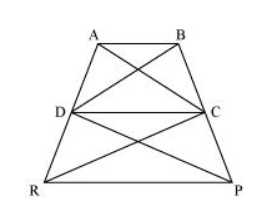Question.
In the given figure, $\operatorname{ar}(\mathrm{DRC})=\operatorname{ar}(\mathrm{DPC})$ and ar $(\mathrm{BDP})=\operatorname{ar}(\mathrm{ARC}) .$ Show that both the quadrilaterals $A B C D$ and $D C P R$ are trapeziums.
Solution:

It is given that
Area $(\Delta \mathrm{DRC})=$ Area $(\Delta \mathrm{DPC})$
As $\triangle \mathrm{DRC}$ and $\triangle \mathrm{DPC}$ lie on the same base $D C$ and have equal areas, therefore, they must lie between the same parallel lines.
$\therefore \mathrm{DC} \| \mathrm{RP}$
Therefore, DCPR is a trapezium.
It is also given that
Area $(\Delta \mathrm{BDP})=$ Area $(\Delta \mathrm{ARC})$
$\Rightarrow$ Area $(B D P)-$ Area $(\Delta D P C)=\operatorname{Area}(\Delta A R C)-\operatorname{Area}(\Delta D R C)$
$\Rightarrow$ Area $(\Delta B D C)=$ Area $(\triangle A D C)$
Since $\triangle B D C$ and $\triangle A D C$ are on the same base $C D$ and have equal areas, they must lie between the same parallel lines.
$\therefore A B \| C D$
Therefore, ABCD is a trapezium.

It is given that
Area $(\Delta \mathrm{DRC})=$ Area $(\Delta \mathrm{DPC})$
As $\triangle \mathrm{DRC}$ and $\triangle \mathrm{DPC}$ lie on the same base $D C$ and have equal areas, therefore, they must lie between the same parallel lines.
$\therefore \mathrm{DC} \| \mathrm{RP}$
Therefore, DCPR is a trapezium.
It is also given that
Area $(\Delta \mathrm{BDP})=$ Area $(\Delta \mathrm{ARC})$
$\Rightarrow$ Area $(B D P)-$ Area $(\Delta D P C)=\operatorname{Area}(\Delta A R C)-\operatorname{Area}(\Delta D R C)$
$\Rightarrow$ Area $(\Delta B D C)=$ Area $(\triangle A D C)$
Since $\triangle B D C$ and $\triangle A D C$ are on the same base $C D$ and have equal areas, they must lie between the same parallel lines.
$\therefore A B \| C D$
Therefore, ABCD is a trapezium.
Click here to get exam-ready with eSaral
For making your preparation journey smoother of JEE, NEET and Class 8 to 10, grab our app now.
